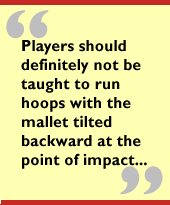
|
Back to |
| The Front Page |
| The Game |
|
Coaching the Fundamentals of the Stroke Part Two: Some Points on Hoop Making by John Riches, Australian Correspondent Posted July 31, 1997
|
| |||||||||||||
In a part of the world where coaching is taken seriously, John Riches has the highest certification given for coaching croquet in Australia. This is the second of a series of short articles focused on various aspects of the croquet stroke. The articles not only attempt to answer the question, "How should this be taught to most novice players?" but also invite comparisons you can draw between Riches' advice to coaches and your own playing style.
South Australian Coaching Committee has concluded that it is best to teach players to run hoops with the mallet sloping slightly FORWARD at impact, although this does not mean they should deliberately hit down on the ball. The forward slope is achieved by standing slightly closer to the ball than for a roquet.
 When you are making a hoop from more than two feet out, it will
make little difference; but from closer in the best way to avoid the
unwanted skidding effect (mentioned in the same article) is to use a flat
swing with the mallet tilted slightly forward. This presses the ball lightly
onto the lawn surface, thus checking the bottom of the ball while the top
starts to roll forward. This results in more topspin (or "forward roll" to
kick the ball through the hoop when it touches the sides) than can be
achieved by hitting up through the ball.
When you are making a hoop from more than two feet out, it will
make little difference; but from closer in the best way to avoid the
unwanted skidding effect (mentioned in the same article) is to use a flat
swing with the mallet tilted slightly forward. This presses the ball lightly
onto the lawn surface, thus checking the bottom of the ball while the top
starts to roll forward. This results in more topspin (or "forward roll" to
kick the ball through the hoop when it touches the sides) than can be
achieved by hitting up through the ball.
Of course, if you can guarantee to hit straight enough, it will not matter much what sort of action you use. It is quite possible to lift the mallet up through the ball even though the handle is sloping slightly forward, and this is probably the action that the writer of the article was intending to describe. However, this involves a sudden lifting of the arms and/or shoulders which has to be accurately controlled and correctly timed. This method may be useful for advanced players, but in our opinion should not be copied by the average club player.
 In the AUSTRALIAN CROQUET MANUAL, Ron Sloane comments: "Some
players impart forward spin by tilting the mallet forward ... others
impart forward spin by hitting up to the ball." I suggest that it is
possible, though for most players inadvisable, to do both things at once;
but players should definitely not be taught to run hoops with the mallet
tilted backward at the point of impact, which is often associated with a
stop-shot action that is also counter-productive. A perfectly flat mallet
at impact is okay, but can cause skidding without forward spin, as the
article correctly notes.
In the AUSTRALIAN CROQUET MANUAL, Ron Sloane comments: "Some
players impart forward spin by tilting the mallet forward ... others
impart forward spin by hitting up to the ball." I suggest that it is
possible, though for most players inadvisable, to do both things at once;
but players should definitely not be taught to run hoops with the mallet
tilted backward at the point of impact, which is often associated with a
stop-shot action that is also counter-productive. A perfectly flat mallet
at impact is okay, but can cause skidding without forward spin, as the
article correctly notes.
It is possible that different lawn conditions could make the method we recommend less justifiable in other areas. Our ground in South Australia is usually fairly hard, so the hoops are more rigidly set. The type of grass in South Australia is quite different from that in most other regions, and this may make a difference. The change to Dawson balls also made a difference, requiring more forward spin; and our low rainfall could also be a factor, as wet balls slide through hoops more easily than dry balls, without the need for much spin. I would be interested to hear from readers with further or differing ideas.
E-Mail: John.Riches@Adelaide.on.net